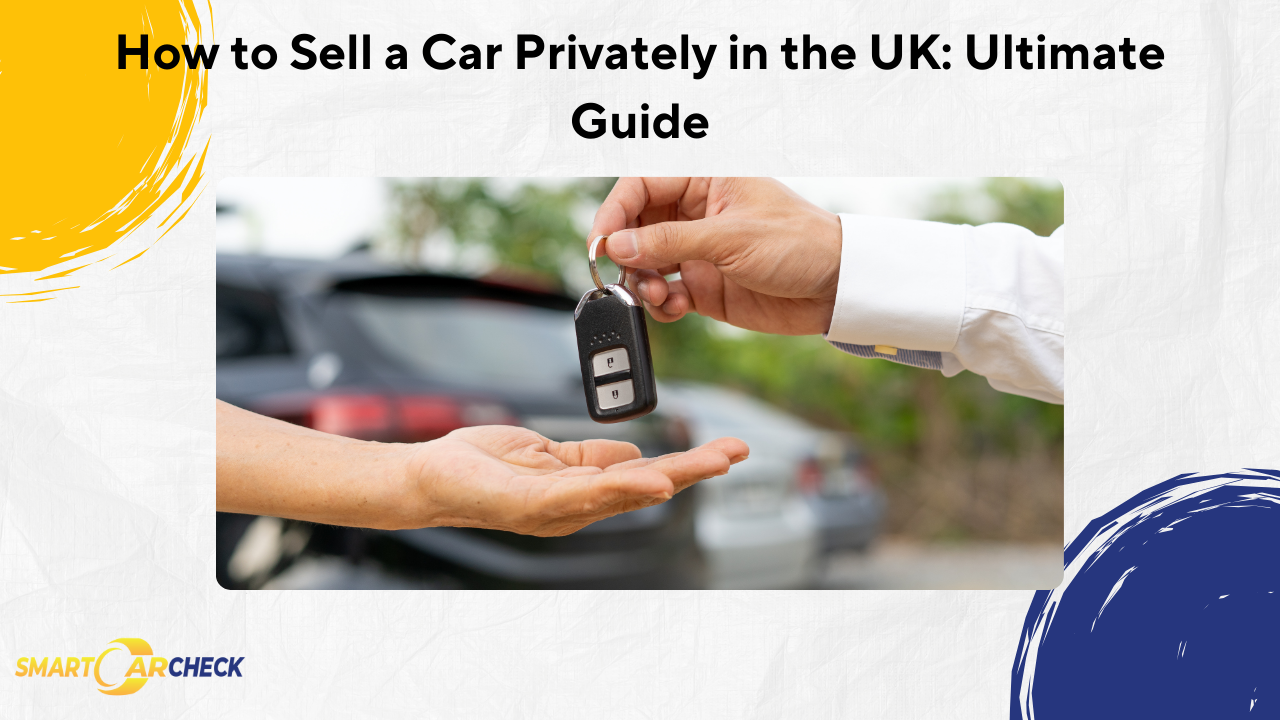Selling car privately in the UK is a smart way to get the best price for your used vehicle. Unlike part-exchanging or selling to a dealership, private sales let you negotiate directly with buyers, giving you more control over the final deal.
However, the process can feel overwhelming if you’re unsure where to begin. This guide provides step-by-step advice to help you navigate selling your car privately from preparing the vehicle to completing the paperwork, safely, legally, and efficiently.
How To Selling Car Privately in the UK
Here are the steps to follow:
Step 1: Ensure your car is in good working order
Before you even think about putting your car up for sale, you need to ensure it is in good working condition. You can inspect and check all parts yourself, but the best way is to hire a professional to inspect your car.
An inspection helps spot defects, and you can get them fixed on time. Next, focus on carrying out proper maintenance and repairs if necessary.
You can also take an MOT test if your vehicle is due for a test or will be due soon. Showing potential buyers a recent MOT certificate can boost your chances of a successful sale.
Nobody wants to buy a damaged vehicle, and even if you’re able to sell it off, you may end up receiving less than the car’s resale value and maybe even get into legal trouble.
Step 2: Clean your vehicle
When it comes to selling anything, including cars, first impressions can make all the difference. You wouldn’t buy a dirty car, so why should you expect anyone else to?
That’s why you should at least wash your car before you show it to any potential buyer.
Ideally, interior detailing should also be in order to provide the best impression possible.
You can even take it step further and use a professional detailing service to remove tough stains, odors, dirt, and even polish the surface. With these steps, you can make your vehicle’s appearance significantly better and catch the buyer’s eyes, and even improve its value.
Step 3: Get the documents ready
Nothing screams shady business louder than missing papers on a car. Having all documents presented during a sale can build up trust for the buyer.
Here are some documents that you should prepare:
- V5C registration certificate: This proves your ownership and is necessary for transferring ownership to the buyer. You can sell a car without the V5C, but it’ll come with many complications.
- MOT certificate: If your car is older than three years, you need to get an MOT certificate for it. This certificate verifies that the vehicle meets the safety standards.
- Service history: Provides a record of all maintenance and repairs, showing the car has been well-cared for. It’s not required by law, but prospective buyers are likely to be interested in a vehicle’s service history. It shows just how well the vehicle has been taken car of in the past.
- Receipts for parts: Demonstrates any recent investments in the car, such as new tyres or a replaced battery. If any part of your car has been modified, you need to make sure the buyers are fully aware of this.
- Form V317: Needed if you’re retaining or transferring a private registration number. Make sure this form is filled out and sent to the DVLA for processing.
Note that you will need to apply to update your V5C if you’ve changed your name or address or made changes to your vehicle along the line.
Having these documents organised and ready to present will make the selling process more efficient, help you get the best price, and increase buyer confidence.
Step 4: Car history report
A car history report shows a comprehensive overview of the car’s past, including any insurance claims, high-risk alerts, mileage history, MOT history, MOT and tax due dates, stolen records, outstanding finance checks, vehicle registration details, and more.
A history report shares information about your car proves just how reliable your vehicle is, and makes the process even more transparent. You can use our reg check tool to get a car history report for your sale. Try it now!
It’s illegal to sell a car you do not fully own, so keep in mind that you will need to settle any outstanding finance before selling your vehicle privately.
READ ALSO: What Car Buyers Need to Know about Insurance Write-Offs
Step 5: Advertise in online marketplaces
Now that you’ve put together your documents and gotten your car ready for sale, the next step is to advertise.
There are several classified sites and marketplaces where you can put up your car for sale. You can try social media platforms, such as Craigslist, Facebook marketplace, eBay, and others.
You could also consider auctions, but if you want the most money for your vehicle, auctions shouldn’t be your go-to unless you’re selling a classic car.
You can choose to use any popular classified site with good ratings and reviews, but remember that you may get charged for placing your ads, so choose wisely.
You can also place ads on several platforms to have more options/buyers to choose from and get the best deal.
Step 6: Advertise your car
An effective car listing is key to attracting serious buyers. This involves setting the right price, writing a compelling advert, and taking high-quality photos. You’ll need to follow these instructions:
- Set the right price
- Research the market value of similar cars using online tools and websites. You’ll also need to use a free car valuation tool online to get an accurate price for your car.
- Consider factors such as age, mileage, condition, and service history while valuing your car.
- Set a competitive price that reflects the car’s value but allows room for negotiation. You can go a bit lower than the actual worth, but that’s fine. Most prices are usually reduced during negotiations.
- Write the advert
- Provide a detailed description of the car, including make, model, year, mileage, and condition.
- Highlight key features and recent maintenance or upgrades.
- Be honest about any faults or issues to build trust with potential buyers.
- Take high-quality photos
- Ensure the car is clean and well-presented.
- Take clear, well-lit photos from multiple angles, including the exterior, interior, and any special features.
- Include close-ups of important details like the dashboard, tyres, and engine.
Combining these elements into a well-crafted listing will make your car stand out, attract more interest, and ultimately lead to a quicker sale.
Step 7: Arrange viewing and test drives
If you find a serious car buyer with interests aligning with yours, you can arrange for a viewing.
You can invite the buyer to your home or a familiar area.
Typically, car buyers might want to verify your house address matches the one listed on your car’s documents.
Some people usually come with a professional mechanic for inspections. Allow them enough time to inspect your car, but don’t give them the keys.
Ideally, you should expect them to request a test drive as well to see if it feels right for them.
You should also verify that they have a valid driver’s licence and ask for permission to take a picture of it—just to be safe.
Step 8: Negotiate the prices
Now that you’ve reached the negotiations stage, you can tell that your car is attractive and the buyer is determined to make the purchase, so you can confidently carry out negotiations.
Remember, you already have a price in mind, so you need to ensure that you don’t lower the price below the average resale value. If you and your prospective buyer cannot come to an agreement, it’s okay to let them walk away.
They may call again later or you may even get a better offer. There’s absolutely no need to settle for whatever low amount they are willing to pay. If negotiations work fine, then you can moving forward to the next step – payment.
Step 9: Sort out the payment
You’ve followed all the steps and passed negotiations; now, how do you get paid? Most of the time, the buyer will not have thousands of pounds in their possession during purchase. So you will have to discuss payment methods and choose the best and most secure one for you.
Here are the main options:
- Cash: You can accept cash payments if you want a quick sale, as you can get paid there and then, but count it carefully and ideally in a bank or secure location. Receiving cash payments at the bank helps to remove the fear of being handed fake notes.
- Bank transfer: Safe and traceable. Bank transfers are more accessible since they can be made from any location. However, they take longer. Make sure the funds are in your account before handing over the car.
- Cheque or banker’s draft: Only accept from reputable buyers. Cheques are not as common as the other methods listed above, but they are also an option you can work with. Wait for the funds to clear before completing the sale.
Have you received the payment? Yes? Congratulations! You’ve sold your car.
Now, you need to prepare the final sale receipts for the private car. These receipts should have basic specifications of the car, including the year, make, model, mileage, and agreed-upon price, and you should try to include a note saying it was “sold as seen” to avoid disputes in the future.
Create two copies of this receipt and hand one over to the buyer. Make sure each receipt is signed by both parties.
Step 10: Notify the DVLA of the sale
Now, all that’s left is to transfer the necessary documents, including car history documents, to the buyer and notify the DVLA about the sale.
Notify the DVLA (Driver and Vehicle Licensing Agency) to officially transfer vehicle ownership. This informs the DVLA that you will no longer be responsible for the car and any associated legal obligations.
These are the steps to follow:
- Fill out the relevant sections of the V5C registration certificate, including the new owner’s details.
- Both you and the buyer must sign the certificate in the appropriate sections.
- Send the completed V5C form to the DVLA. This can be done online via the DVLA website or by mailing the form to the address provided on the V5C document.
- Provide the new keeper supplement (V5C/2) to the buyer as their proof of temporary ownership until the new V5C arrives.
- The DVLA will send a confirmation letter within four weeks. Keep this letter as proof that you have notified the DVLA of the sale.
That’s all! You can also pass along any ‘extras’ such as locking wheels, nut adapters, and spare keys.
What You Should Keep in Mind While Selling Cars Privately
Although selling privately prevents the dealership from taking a percentage of your money, it comes with its own risks. The most common ones are:
- Fake payments (counterfeit cash, bounced cheques, fraudulent transfers)
- Phishing scams (buyers asking for personal information)
- Test drive risks (invalid driver’s license, no insurance coverage)
- Personal safety (meeting strangers)
- Time-consuming process (handling inquiries, viewings, negotiations)
- Dealing with unserious buyers
- Liabilities could arise if the DVLA is not informed about the sale
- If your car is not roadworthy and is sold, you may have to face legal consequences
- Marketing and ads on classifieds and some social media platforms are not free
If you’re ready to sell your car online, you should be prepared for these risks and find a way to avoid them.Overall, get all vehicle documents, including a car history report, get MOT checks to ensure your car is in road-worthy condition, place car adverts, and negotiate properly. With the steps above, you should be able to sell your car quickly and get the most value for your car.


